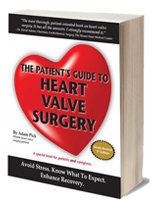Surgeon Q&A: Patient Criteria for Robotic Mitral Valve Surgery
Written By: Allison DeMajistre, BSN, RN, CCRN
Medical Expert: Kevin Hodges, MD, Cardiac Surgeon, Northwestern Medicine, Chicago, Illinois
Reviewed By: Adam Pick, Patient Advocate, Author & Website Founder
Published: August 14, 2025
As surgical techniques advance, minimally-invasive and robotic procedures are now viable options for many patients in need of mitral valve repair. In the past, the only alternative available was open-heart surgery with one long incision to the front of the chest, known as a sternotomy. In contrast, minimally-invasive surgery only requires a few small incisions where surgeons insert small, high-powered cameras, surgical tools, or robotic arms to assist with the valve repair.
Since minimally-invasive techniques offers advantages including faster recovery, lower risk of infection, less pain, and shorter hospital stays, robotic surgery may be a surgeon’s preferred choice when feasible. However, limitations do exist when it comes to patient candidacy, requiring surgeons to evaluate the suitability of each case carefully.
We often receive questions from patients who want to know if they are eligible for minimally-invasive and robotic heart valve surgery. The most recent question comes from John, who asked, “What are the criteria for surgeons to use minimally invasive techniques? My wife is very thin. Can the robot be used? Are there other constraints that limit the use of the robot?” Adam Pick, founder of HeartValveSurgery.com, met with Dr. Kevin Hodges to answer John’s question. Dr. Hodges is a leading minimally-invasive cardiac surgeon who specializes in robotic mitral valve repair at the Northwestern Medicine Bluhm Cardiovascular Institute in Chicago, Illinois.
Patient Eligibility for Minimally-Invasive and Robotic Heart Valve Surgery
Here are the key insights shared by Dr. Hodges:
- Patient safety is the primary criterion. “That’s a great question,” said Dr. Hodges. “I’ll start broadly and then we can talk about the specifics of John’s wife. We want to offer the most minimally-invasive option while not compromising on the quality and safety of the operation, so that means we put patients through a couple of preoperative tests. Dr. Hodges explained that patients will have a CT scan to check their coronary arteries and an echocardiogram to ensure that anatomically, there is no reason a robotic surgery will be less safe than a conventional approach with a sternotomy. “As long as a patient meets the criteria in terms of their heart function, valve anatomy, as well as their vascular anatomy, we almost always offer a minimally-invasive or robotic approach.”

- Surgeons can adjust to patient-specific body types. “To the specific question of a very thin body habitus, we see that situation all the time,” said Dr. Hodges. “In fact, we had a case like that yesterday. It’s generally no problem.” He explained that surgeons take into consideration specific body types and will make adjustments regarding how they position robotic instruments, but it’s not generally a problem for a robotic approach.
Thanks Dr. Hodges and Northwestern Medicine!
On behalf of all the patients in our community, thank you, Dr. Kevin Hodges, for everything you and your team are doing at Northwestern Medicine in Chicago, Illinois!
Related links:
- Surgeon Q&A: Robotic Heart Surgery Conversion from Minimally-Invasive to Sternotomy
- Patient Webinar: 5 Warning Signs You May Need Heart Valve Surgery
- Free eBook: 6 Expert Tips for Heart Valve Patients
Keep on tickin,
Adam
P.S. For the deaf and hard-of-hearing members of our patient community, we have provided a written transcript of our interview with Dr. Hodges below.
Video Transcript:
Adam Pick: Hi everybody, it’s Adam with HeartValveSurgery. com, and today we’re in Chicago, Illinois. I’m thrilled to be joined by Dr. Kevin Hodges, who is a leading minimally invasive surgeon with a specialty in robotic mitral valve repair at the Northwestern Medicine Bluhm Cardiovascular Institute.
Dr. Hodges, it is great to see you again and thanks for being with me today. Thanks Adam. Yeah, so we’re going to answer a patient question that came in for you. This one comes in from John. He asks, “What are the criteria for surgeons to use minimally invasive techniques? My wife is very thin. Can the robot be used? Are there other constraints that limit the use of the robot?”
Dr. Kevin Hodges: That’s a great question. I’ll start broadly and then we can talk about the specifics of this gentleman’s wife. We want to offer the most minimally invasive option that we can while not compromising on the quality of our operation or the safety of our operation and so that means we put patients through a couple of preoperative tests.
We do a CT scan We check their coronary arteries and we do an echocardiogram and basically make sure that anatomically there’s no reason that a robotic operation will be less safe than the conventional approach and as long as a patient meets, you know, a few in terms of their heart function, their valve anatomy, and then their vascular anatomy we almost always offer a minimally invasive or robotic approach.
To the specific question of a very thin body habitus, we see that situation all the time. In fact, we had a case just like that yesterday. It’s generally no problem. It does, create some things that we consider in terms of how we position the robotic instruments, but generally not a problem for a robotic approach.
Adam Pick: Great. Well, John, I hope that helps you and your wife and Dr. Hodges on behalf of John and all the patients at heart valve surgery. com patients all over the world. Thanks for everything you and your team are doing here at Northwestern medicine in Chicago. Thanks for being with me today.
Dr. Kevin Hodges: Thanks Adam.




